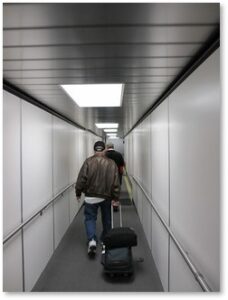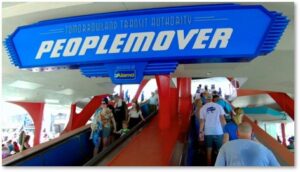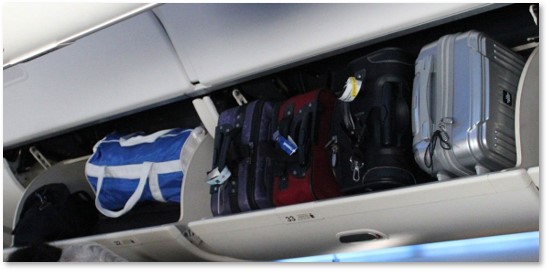 According to The Wall Street Journal, Southwest Airlines is investing time, money, and manpower to figure out how to load their planes faster and more efficiently. They are aiming for cutting two to five minutes off the typical 40-mijnute turn-around time by making passenger boarding more efficient..
According to The Wall Street Journal, Southwest Airlines is investing time, money, and manpower to figure out how to load their planes faster and more efficiently. They are aiming for cutting two to five minutes off the typical 40-mijnute turn-around time by making passenger boarding more efficient..
“The Airline Experiment to Make Boarding Less Awful” by Dawn Gilbertson
That’s good news. I wish the other airlines were doing the same. What Southwest is doing, however, can easily apply to any airline looking to improve their turn-around time.
What Southwest is Testing
Southwest is testing 11 concepts at gates C13-16 at Hartsfield-Jackson Atlanta International Airport, beginning with gate signs that tell passengers they are entering an “innovation zone.” Here is what else their innovation team is rolling out:
- Posters and music in the jetway
- Boarding planes from front and back simultaneously
- Paperless take-off documents
- A group chat among workers at the gate, on the plane and on the ground to quickly get a handle on things like gate-checked bags.
- A roving employee with a mobile device to check oversize bags or register pets long before boarding begins.
- Video monitors on the stanchions where boarding passengers line up that display a countdown, an alert when important announcements are being made and flashing lights when boarding begins.
What Southwest is Not Doing
Good ideas. I hope they work.
 Here’s what Southwest’s innovation team is not doing: talking to their passengers. Now, I don’t ever fly on Southwest because I like having an assigned seat and I don’t enjoy a mob scene at the gate.
Here’s what Southwest’s innovation team is not doing: talking to their passengers. Now, I don’t ever fly on Southwest because I like having an assigned seat and I don’t enjoy a mob scene at the gate.
But we passengers have a lot of experience in boarding airplanes and most of us probably have some ideas as well. It would be wise of any airline to tap that expertise for suggestions on how to speed things up.
3 Ideas for Faster Boarding
Most of my ideas for faster boarding come from simple common sense.
-
Boarding the plane from back to front, including First Class
Could this be any simpler? You can speed up the boarding process by keeping the aisles clear of people who are stuffing an over-stuffed carry-on into an already-stuffed overhead bin three rows away from their seat and then trying to get back to their seat. Do this by boarding the back rows first and then load the subsequent rows in front of them, loading from window seats to aisle seats.
 This actually happened one year at Washington National before it became Reagan International. My team and I were working an annual trade show that took place in January.
This actually happened one year at Washington National before it became Reagan International. My team and I were working an annual trade show that took place in January.
One year, we had packed up the show and were trying to get home ahead of a big snow storm that was coming down the coast. Both crew and passengers wanted to get that plane in the air, especially because National has a curfew on take-offs. I remember that curfew as 10:00 p.m. If the plane didn’t fly before that time, it couldn’t go out until the next day—when it would be snowed in.
Smooth, Seamless, and Fast
The gate crew lined everyone up in the corridor with the folks in the back rows at the front. Everyone then stood in their row and seat position all the way down to the first seats. As soon as the plane was cleared to board, the gate crew called, “Row 28 — Go!” “Row 27 — Go!” and people filed down the jetway and into the plane.
The process was smooth and seamless—and fast. Of course, everyone cooperated because we wanted to get home and, back then, carry-ons weren’t the problem they are now. But my point is that the gate crew created and implemented a process that made sense. And it worked.
The” group method” of boarding, on the other hand, has never made sense to me because the groups don’t seem to align with any seating pattern on the plane. Thus, we wait while others find their seats, stow their carry-ons, and get settled. This takes time, especially for families.
-
Charging fees for carry-ons while checked baggage is free
The stupidest thing the airlines have done in the last 20 years was to charge for checked baggage and make carry-ons free. There are three reasons why this doesn’t make sense and they all involve human nature.
- Real estate in the passenger compartment is expensive but the space in the belly of the plane is essentially free. Thus, they are giving away the prime space and charging for what is less desirable. Result: Passengers are incentivized not to check their baggage, instead bringing more and bigger luggage to shove into overhead bins.
- The increased demand for carry-on space in the overhead bins creates exactly the kind of confusion and delays that the airlines are trying to avoid. Result: Carry-ons slow down the boarding process—and thus the turn-around time.
- Passengers will try to take their luggage with them if they have to evacuate the plane. This is stupid and dangerous but it is human nature. Result: Evacuation time is slowed down, which could cost lives in a crisis.
Charging fees for carry-ons would reduce the amount of luggage brought into the passenger compartment and, at the same time, give the airlines the opportunity to charge more for the great luxury of filling the overhead bins. Business passengers, the biggest proponents of not checking luggage, could expense it.
-
Hiring someone from Disney theme parks
 No company moves large numbers of people faster and more efficiently than Disney theme parks.
No company moves large numbers of people faster and more efficiently than Disney theme parks.
The WSJ article says that Southwest’s innovation team regularly visits theme parks for inspiration. Great. Now recruit someone out of the Disney organization with experience in people-moving and give that person the power and authority to make changes.
An Improved Boarding Process
Just imagine a smooth, efficient boarding process that doesn’t involve standing in the aisle while the guy in front of you tries to shove something as big as a body bag into an overhead bin. Imagine not having so wait for people to get organized and sit down so you can get to your seat, which is located behind them.
Wouldn’t that be an improvement? I think it would sure be faster.
Related Post:
- When Carry-ons Kill: You Have 90 Seconds
- The World’s Airline Travel Mess


My solution to this? Have a disability so that you can board in the very first wave (“families and people with disabilities who need extra time”). This solution does have its downsides in other areas of my life….
I agree with most of your comments Aline, but I saw an even better form of boarding from an old Mythbusters episode some years back. They went through a half dozen or so scenarios of boarding a plane with 100 or more people, and the one that worked the best was this: Folks with window seats go first, starting with the back of the plane and going forward from there. Next was middle seats, from back to front, and then finally aisle seats, again back to front. The only downside that slowed things down was that you had to wait until the last person seating near the front of the plane had seated themselves. How’s that for an idea?
I think it’s a very good ide — and a big improvement over the way boarding is handled now.